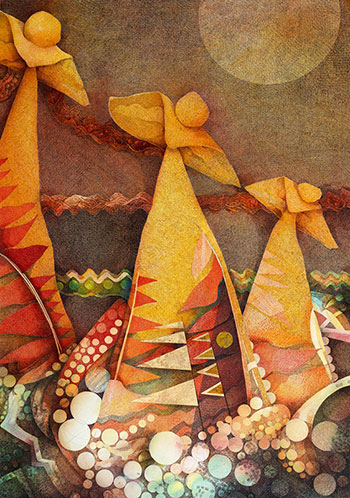
Conferred the title Emeritus Professor, Visual Arts upon retirement from Charles Sturt University, David Green relocated to Buderim to immerse himself in his own art practice. Green’s subject matter has ever evolved from reminiscences of earlier life experiences tinged with academic nuances. Speaking of the inception for his current exhibition he discloses, “A random something had brought to mind a brief conversation between my mother and a professor during a lunch gathering, post my graduation from London’s Royal College of Art in 1964.” Green goes on to tell that his mother was not particularly impressed with the platitudes being proffered at this occasion. The memory of that long ago incident furnished inspirational impetus.
“With these new works I wanted to rekindle the relationship subtleties between child and mother. I wished to capture that point in time when a child offers a project or perhaps an artwork for her estimation,” informs Green. “She might respond, ‘it’s lovely dear, go and fill the coal bucket please’. Praise and practical demand can sometimes have unforeseen consequences.”
“I have created cameos not founded on historical accuracy but are reliant on grossly inaccurate interpretation of extant artworks,” Green imparts. “This is my pretend world.” His extraordinarily intricate creations compel close perusal, both in the rendering and the envisaged scenarios that allude to several very famous artists. Green beckons the viewer to partake in his imaginative journeying.
Sandcastles With Flags and Angels Wings depicts a potential childhood episode between the Spanish architect Antoni Gaudi and his mother. “Imagine a beach in Catalonia, the water cool and inviting under a hot summer sun,” Green bids. “A boy is engrossed in building an architectural delight – a sandcastle decorated with swirls and ornamental detail carved into its surfaces. ‘It’s lovely dear, now eat your ice cream before it melts’ his mother remarks. Later that day the incoming tide swept away young Antoni’s magnificent first design for the Sagrada Famillia.” Gaudi’s actual basilica was never completed and is now a UNESCO World Heritage site.
Henri Have You Fed Your Fish Today conjures a young Henri Matisse. “Now imagine you have moved further north to France,” Green continues. “A young boy is diligently drawing a bowl of golden flowers on the kitchen table. It is late afternoon. The light is beginning to fade, blurring the blossoms and melding them into a golden mass. Below, goldfish lazily swim within the glass bowl. Henri obeyed his mother’s request but had inadvertently overfed the fish resulting in their demise. Such was his remorse, Henri was not to paint goldfish again until 1912.”
Green relays that the work It Will Look Lovely When You Finish Colouring It In furthers the travelling through an alternative history of art, this time up to Belgium. Here a youth is attempting to portray a rather large fish in a container. Water rushes through the vessel, becoming magically solidified into gold and then reverting back again to water. The boy’s drawing however was never finished, the family’s supper that night was the fish! For Green, this work pays homage to the surrealist artist Rene Magritte known for his depictions of familiar objects in unexpected contexts. Magritte did many paintings with images of a fish in human form.
“The fourth stop on our journey is to Cheshire, England,” declares Green. He explains that Andy Come In and Have Your Tea refers to children’s outdoor ventures being curtailed by mothers calling them home as evening approaches. Amidst dank woodland, one youngster had been arranging stones and sticks in great circles, spirals and cairns when the call came. Green’s illustration is a calling to mind of English sculptor and photographer Andy Goldsworthy, who produced site-specific works made from impermanent organic materials that he thence documented in photographs.
There are other pieces in the exhibition that evince Green’s scenarios where historically significant artists play an underlying role. Albrecht Durer, a famous German Renaissance painter and printmaker, is aspirational in Repairing Albrecht’s Tangle while Call It What You Want Barbara, It’s Still a Donut connotes the abstract, modern sculptures of English-born Barbara Hepworth.
Contrary to most artists, Green begins each new work with an established title, however over time they may be “refined so as not to be unduly cumbersome”. “Having the title in place gives me a clearer understanding of what I’m sensing to achieve,” he tells. Interestingly, despite the names in his titles, the works are completely non-figurative. They are imagined realms loosely pertaining to “extant artworks”.
Intrigue is generated by the visual organisation of surfaces. Green’s incredibly intricate large works take months to complete. Many hours are spent every day delineating his musings on robust sheets of paper with inks, coloured pencils, gold and copper foil, as well as 23carat gold leaf. In the interaction between medium and meaning all sense of time is suspended and curious, we follow Green into his “pretend worlds” where past, present and future possibilities meld.
JACQUELINE HOUGHTON
Receive e-mail updates on our exhibitions, events and more
Subscribe Now